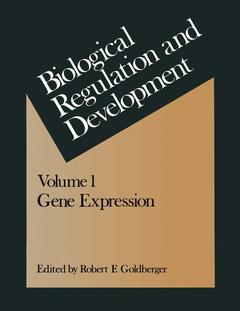Description
Biological Regulation and Development, Softcover reprint of the original 1st ed. 1979
Gene Expression
Biological Regulation and Development Series, Vol. 1
Language: English
Subject for Biological Regulation and Development:
Keywords
DNA; Glutamin; Nucleotide; RNA; amino acid; biology; enzyme; enzymes; gene expression; metabolism; mutation; nucleic acid; tRNA; transcription; translation
Publication date: 05-2012
558 p. · 18.9x24.6 cm · Paperback
558 p. · 18.9x24.6 cm · Paperback
Description
/li>Contents
/li>
The motivation for us to produce a treatise on regulation was mainly our convic tion that it would be fun, and at the same time productive, to approach the subject in a way that differs from that of other treatises. We had ourselves written reviews for various volumes over the years, most of them bringing together all possible facts relevant to a particular operon, virus, or biosynthetic system. And we were not convinced of the value of such reviews for anyone but the expert in the field reviewed. We thought it might be more interesting and more instructive-for both author and reader-to avoid reviewing topics that anyone scientist might work on, but instead to review the various parts of what many different scientists work on. Cutting across the traditional boundaries that have separated the subjects in past volumes on regulation is not an easy thing to do-not because it is difficult to think of what interesting topics should replace the old ones, but because it is difficult to find authors who possess sufficient breadth of knowledge and who are willing to write about areas outside those pursued in their own laboratories. For example, no one scientist works on suppression per se. He may study the structure of suppressor tRNAs in Escherichia coli, he may study phenotypic suppression of various characters in drosophila, he may study polarity in gene expression, and so on.
1 Strategies of Genetic Regulation in Prokaryotes.- 1 Introduction.- 2 The Prokaryotic Chromosome and Its Genes.- 3 Gene Clustering and the Operon Concept.- 4 Regulatory Molecules and the Genes with Which They Interact.- 5 Induction and Repression.- 6 Autogenous Regulation.- 7 Integration of Regulatory Mechanisms.- 8 Translational Control.- 9 Conclusion.- References.- 2 Structure of Complex Operons.- 1 Evolution of the Operon Concept.- 2 Types of Complex Operons.- 3 Evolution of Complexity.- 4 Methodological Implications for Studies of Genome Organization.- References.- 3 Autogenous and Classical Regulation of Gene Expression: A General Theory and Experimental Evidence.- 1 Introduction.- 2 Repressors and Activators.- 3 Inducible Systems.- 4 Repressible Systems.- 5 Autonomous Systems.- 6 Discussion.- References.- 4 Regulation of Enzyme Synthesis in the Bacteria: A Comparative and Evolutionary Study.- 1 Introduction.- 2 The Nature of the Evidence.- 3 The Molecular Basis of Regulation of Gene Expression.- 4 The Biosynthesis of Aromatic Amino Acids.- 5 Catabolic Pathways.- 6 Nitrogen Metabolism and Regulation.- 7 Experimental Evolution.- 8 Discussion.- References.- 5 Importance of Symmetry and Conformational Flexibility in DNA Structure for Understanding Protein-DNA Interactions.- 1 Introduction.- 2 Symmetry in DNA Structure.- 3 Flexibility in DNA Structure—The Kink.- 4 Detailed Models for Drug-DNA Binding.- 5 Nature of DNA Breathing.- 6 Organization of DNA in Chromatin.- 7 Active Form of DNA in Transcription, Replication, and Recombination.- 8 Operator-Repressor Interactions.- 9 Concluding Remarks.- References.- 6 Some Aspects of the Regulation of DNA Replication in Escherichia coli.- 1 Introduction.- 2 DNA Replication in Escherichia coli.- 3 Stoichiometry of DNAReplication.- 4 Regulation Is at the Level of Initiating Chromosome (or Replicon) Replication.- 5 The Replication Complex.- 6 The Destruction of the Replication Complex.- 7 Repair Replication (a Possible Example of Regulative Assembly).- 8 Regulation of the Quality of DNA Replication.- 9 RNA and the Initiation of Replication.- 10 Conclusion.- References.- 7 Genetic Control Signals in DNA.- 1 DNA Control Signals.- 2 Transcription Control Signals.- 3 The Promoter and Its Regulation.- 4 The Terminator and Its Function.- 5 Terminator Regulation.- 6 Concluding Remarks.- References.- 8 On the Molecular Bases of the Specificity of Interaction of Transcriptional Proteins with Genome DNA.- 1 Introduction.- 2 Molecular Bases of Protein-Nucleic Acid Interactions.- 3 The Problem of the Other Sites.- 4 The Lactose Operon of Escherichia coli.- 5 Extension to Other Transcription Regulatory Systems.- References.- 9 Genetic Signals and Nucleotide Sequences in Messenger RNA.- 1 Introduction.- 2 Ribosome Recognition of Initiation Signals.- 3 Sequences Directing Elongation of Polypeptide Chains.- 4 RNA · RNA Interactions in Ribosome Function.- 5 Are Eukaryotic Messengers Different?.- References.- 10 The Role of tRNA in Regulation.- 1 Introduction.- 2 tRNA as a Regulatory Molecule.- 3 tRNA as a Target for Regulation.- 4 tRNA Has Other Functions.- 5 Concluding Remarks.- References.- 11 Suppression.- 1 Introduction.- 2 A Short Synopsis of Suppression.- 3 Some Topics in Molecular Biology Influenced by Analysis of Genetic Suppression.- 4 Nonsense Mutations in the Escherichia coli lacI Gene.- 5 Current Developments in Eukaryotic Suppression.- 6 Outlook.- References.- 12 Regulation of the Protein-Synthesizing Machinery—Ribosomes, tRNA, Factors, and So On.- 1 Introduction.- 2 The Concepts andElements.- 3. Patterns and Frequencies of Transcription.- 4 The Role of ppGpp in Regulation of the Protein-Synthesizing System.- 5 Ribosome Synthesis during the Cell Cycle.- 6 Afterthoughts.- References.
© 2024 LAVOISIER S.A.S.
These books may interest you

Regulation of Gene Expression 105.49 €



